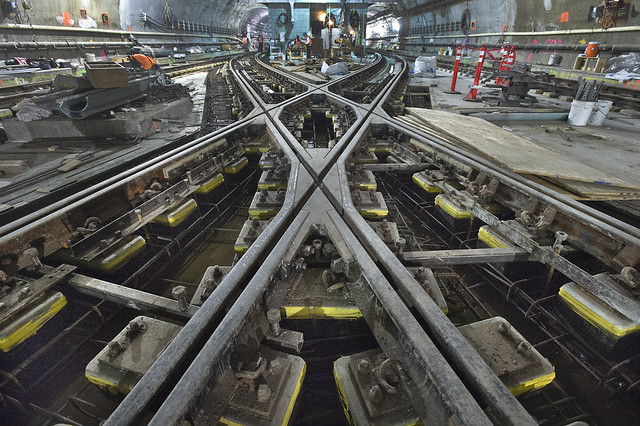
A switch in time (or at least the 7 line extension). Photo: Metropolitan Transportation Authority / Patrick Cashin
I haven’t had a chance to sneak a peek at the 7 line extension work since last February when the MTA lead a press excursion into the work site. In the intervening 16 months though, work has moved forward at a steady clip, and the one-station extension of the 7 line to 34th St. and 11th Ave. is on target for revenue service by next June. Today, the MTA unveiled a new series of photos of the work, and with 12 months left, it’s looking more and more like a subway stop.
We can see that tunnel systems are in place and signals are awaiting incoming trains (though some signals remain wrapped in plastic, not yet ready for tests that should begin in December). Inside the station cavern, subway platforms are taking shape and so are the escalator banks. The switch cabinets in place too, and I believe this area will host the incline elevator that will bring passengers deep underground.
I’ve long been critical of the approach to this project. Losing the station at 41st St. and 10th Ave. is a mistake New York City will live to regret, and I’m skeptical that, even with provisioning in place for two side platforms there, we’ll live to see the 7 make that stop. Additionally, the train could continue south (or even west, if Mayor Bloomberg has his druthers), but for now, we get one stop. That said, that stop will be key in bringing people to one the underdeveloped areas of Manhattan, and growth will boom with a new subway stop.
After the jump, a slideshow of all of the MTA’s photos showing the latest progress at 34th St. and 11th Ave.










 (Nights)
(Nights)

 It’s been nearly six months since Joe Lhota resigned as MTA Chairman and CEO, and after waiting out a slow nomination process and an even slower confirmation process, the MTA finally has a new permanent leader. This evening, the New York State Senate voted to confirm Tom Prendergast as the Chairman and Chief Executive Office of the Metropolitan Transportation Authority. Prendergast, the former president of New York City Transit, had been serving as the interim executive director since Lhota stepped down to run for mayor on January 1, but the Senate waited until the final day of their legislative session to confirm the nomination.
It’s been nearly six months since Joe Lhota resigned as MTA Chairman and CEO, and after waiting out a slow nomination process and an even slower confirmation process, the MTA finally has a new permanent leader. This evening, the New York State Senate voted to confirm Tom Prendergast as the Chairman and Chief Executive Office of the Metropolitan Transportation Authority. Prendergast, the former president of New York City Transit, had been serving as the interim executive director since Lhota stepped down to run for mayor on January 1, but the Senate waited until the final day of their legislative session to confirm the nomination.


